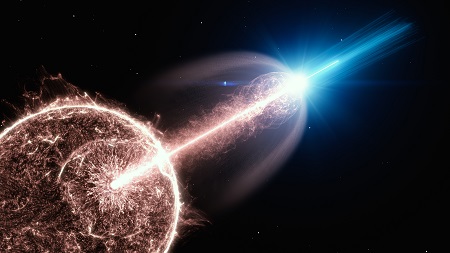
Namibian observatory reveals exceptional cosmic explosion

A specialised observatory in Namibia has recorded the most energetic radiation and longest gamma-ray afterglow of a so-called gamma-ray burst (GRB) to date, the University of Namibia (UNAM) announced.
The observations with the High Energy Stereoscopic System (H.E.S.S.) challenge the established idea of how gamma-rays are produced in these colossal stellar explosions which are the birth cries of black holes, as the international team reports in the journal Science.
German Electron Synchrotron (DESY) Scientist, Sylvia Zhu, one of the authors of the paper, said gamma-ray bursts are bright X-ray and gamma-ray flashes observed in the sky, emitted by distant extragalactic sources.
“They are the biggest explosions in the universe and associated with the collapse of a rapidly rotating massive star to a black hole. A fraction of the liberated gravitational energy feeds the production of an ultrarelativistic blast wave. Their emission is divided into two distinct phases: an initial chaotic prompt phase lasting tens of seconds, followed by a long-lasting, smoothly fading afterglow phase,” Zhu said.
On 29 August 2019 the satellites Fermi and Swift detected a gamma-ray burst in the constellation of Eridanus.
“I do well recall the first internal ‘buzz’ about the event. Our team from UNAM were hosting the international High Energy Astrophysics in Southern Africa (HEASA 2019) conference in Swakopmund, Namibia, between August 28 and 30 that year. A good part of the attendees were H.E.S.S. members, but by far not all of them,” recalled Dr Michael Backes, the head of the H.E.S.S. group at UNAM.
The event, catalogued as GRB 190829A according to its date of occurrence, turned out to be one of the nearest gamma-ray bursts observed so far, with a distance of about one billion light years. The typical gamma-ray burst is about 20 billion light years away.
“We were really sitting in the front row when this gamma-ray burst happened,” explained co-author Andrew Taylor from DESY. The team caught the explosion’s afterglow immediately when it became visible to the H.E.S.S. telescopes. “We could observe the afterglow for several days and to unprecedented gamma-ray energies.”
The comparatively short distance to this gamma-ray burst allowed detailed measurements of the afterglow’s spectrum, which is the distribution of “colours” or photon energies of the radiation, in the very-high energy range.
“We could determine GRB 190829A’s spectrum up to an energy of 3.3 tera-electronvolts, that’s about a trillion times as energetic as the photons of visible light,” explains co-author Edna Ruiz-Velasco from the Max Planck Institute for Nuclear Physics in Heidelberg. “This is what’s so exceptional about this gamma-ray burst – it happened in our cosmic backyard where the very-high-energy photons were not absorbed in collisions with background light on their way to Earth, as it happens over larger distances in the cosmos.”
Established theories assume that the two emission components must be produced by separate mechanisms: the X-ray component originates from ultra-fast electrons that are deflected in the strong magnetic fields of the burst’s surroundings. This “synchrotron” process is quite similar to how particle accelerators on Earth produce bright X-rays for scientific investigations.
However, according to existing theories it seemed very unlikely that even the most powerful explosions in the universe could accelerate electrons enough to directly produce the observed very-high-energy gamma rays. This is due to a ‘burn-off limit’, which is determined by the balance of acceleration and cooling of particles within an accelerator. Producing very-high energy gamma rays requires electrons with energies well beyond the burn-off limit. Instead, current theories assume that in a gamma-ray burst, fast electrons collide with synchrotron photons and thereby boost them to gamma-ray energies in a process dubbed synchrotron self-Compton.
But the observations of GRB 190829A’s afterglow now show that both components, X-ray and gamma ray, faded in sync.
“Looking to the future, the prospects for the detection of gamma-ray bursts by next-generation instruments like the Cherenkov Telescope Array that is currently being built in the Chilean Andes and on the Canary Island of La Palma look promising,” said H.E.S.S. spokesman Stefan Wagner from Landessternwarte Heidelberg. “The general abundance of gamma-ray bursts leads us to expect that regular detections in the very-high energy band will become rather common, helping us to fully understand their physics.”
More than 230 scientists from 41 institutes in 15 countries (Namibia, South Africa, Germany, France, the UK, Ireland, Italy, Austria, the Netherlands, Poland, Sweden, Armenia, Japan, China, and Australia), comprising the international H.E.S.S. collaboration, contributed to this research. H.E.S.S. is a system of five Imaging Atmospheric Cherenkov Telescopes that investigates cosmic gamma rays.
 An artist’s impression of a relativistic jet of a gamma-ray burst (GRB), breaking out of a collapsing star, and emitting very-high-energy photons. (DESY/Science Communication Lab).
An artist’s impression of a relativistic jet of a gamma-ray burst (GRB), breaking out of a collapsing star, and emitting very-high-energy photons. (DESY/Science Communication Lab).













































